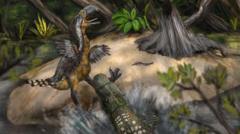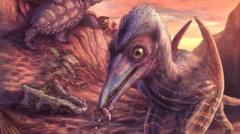The discovery of teeth marks on the fossilized leg bone of a terror bird has unveiled a chilling chapter in the life of this ancient predator. Researchers suggest that approximately 13 million years ago, this formidable bird, known for its size and lethal beak, may have met its demise at the jaws of a larger predator—a caiman-like reptile. The bone, discovered in Colombia’s Tatacoa Desert, showcases bite marks that match those of an extinct species related to today's crocodiles.
Published in the journal *Biology Letters*, the study utilized 3D scans to analyze the bone's features, revealing clear evidence of a violent encounter. “The absence of healing signs on the marks indicates that the terror bird likely died in this confrontation,” explained lead researcher Andres Link from the Universidad de Los Andes. He speculated how the calamitous event marked the last day of this avian creature's existence.
The researched bone was first unearthed over 15 years ago and later identified as belonging to one of these astonishing terror birds, which reached heights of about 2.5 meters during its lifetime. The Tatacoa Desert, once a swampy region, holds a trove of fossils from the Middle Miocene epoch, providing invaluable insight into its ancient ecosystems.
The collaboration with local fossil collector César Augusto Perdomo helped shed light on the bone's origin and its significance. As the team examined various fossil finds, they discovered that the ill-fated terror bird had been closely matched to the predatory Purussaurus neivensis, a sizable caiman that thrived by ambushing its prey. This connection not only highlights the dangers lurking within their environment but also underscores the vulnerability of even the most fearsome creatures of that era.
Dr. Link emphasized how essential each fossil find is for reconstructing historical ecosystems, illustrating how this single bone contributed to a broader understanding of the interactions between dominant predators of the time. He expressed appreciation for how even a small fragment can enrich our perception of ancient life on Earth. Through these findings, paleontologists continue to unravel the complex narrative of survival and predation that defined life millions of years ago.
Published in the journal *Biology Letters*, the study utilized 3D scans to analyze the bone's features, revealing clear evidence of a violent encounter. “The absence of healing signs on the marks indicates that the terror bird likely died in this confrontation,” explained lead researcher Andres Link from the Universidad de Los Andes. He speculated how the calamitous event marked the last day of this avian creature's existence.
The researched bone was first unearthed over 15 years ago and later identified as belonging to one of these astonishing terror birds, which reached heights of about 2.5 meters during its lifetime. The Tatacoa Desert, once a swampy region, holds a trove of fossils from the Middle Miocene epoch, providing invaluable insight into its ancient ecosystems.
The collaboration with local fossil collector César Augusto Perdomo helped shed light on the bone's origin and its significance. As the team examined various fossil finds, they discovered that the ill-fated terror bird had been closely matched to the predatory Purussaurus neivensis, a sizable caiman that thrived by ambushing its prey. This connection not only highlights the dangers lurking within their environment but also underscores the vulnerability of even the most fearsome creatures of that era.
Dr. Link emphasized how essential each fossil find is for reconstructing historical ecosystems, illustrating how this single bone contributed to a broader understanding of the interactions between dominant predators of the time. He expressed appreciation for how even a small fragment can enrich our perception of ancient life on Earth. Through these findings, paleontologists continue to unravel the complex narrative of survival and predation that defined life millions of years ago.


















